When Andrew Reynolds puts his name on something, it’s never just for show. The New Balance Numeric 933 is the product of a career defined by precision, consistency, and an uncompromising approach to skateboarding. Merging the comfort and aesthetic of classic New Balance runners with the durability and support needed to take the repeated impact of skateboarding, the 933 is more than a signature shoe—it reflects how Reynolds skates, lives, and thinks. Every detail, from the layered materials to the midsole tech, was built with purpose. Before we delve deep into the details of the 933, let’s first look at the man himself…
Who is Andrew Reynolds?
Andrew Reynolds was born on June 6, 1978, in Lakeland, Florida. He first picked up a skateboard at the age of nine after seeing a Vision Psycho Stick commercial on MTV. That moment sparked what would become a lifelong obsession. By the time he was in his teens, Reynolds was skating constantly and progressing rapidly. After finishing high school, he moved from Florida to Huntington Beach, California, a hotbed for skateboarding, where his talent quickly caught the attention of industry veterans.
Tony Hawk brought him onto Birdhouse in the early ‘90s. The company was newly formed, and Reynolds was part of a young, stacked team. In 1995, at the age of 17, Reynolds officially turned pro. His style was already distinct: fast, smooth, powerful, and precise, with a clean approach to even the gnarliest tricks. It didn’t take long before he was getting national attention.
His breakout moment came in 1998 with the release of Birdhouse’s landmark video The End. Shot on 16mm film and loaded with high production value and skits, the video culminated in Reynolds’ unforgettable part. He closed it with a now-legendary frontside flip down one of the biggest stair sets skated at that time – a huge, high-impact clip that immediately became part of skateboarding lore. That same year, Thrasher Magazine named him Skater of the Year.
However, Reynolds wasn’t content to be part of someone else’s vision. In 2000, alongside filmmaker and artist Jay Strickland, he launched Baker Skateboards. Baker flipped the script on how a skate brand could look and feel. Where Birdhouse had been relatively polished, Baker was gritty, chaotic, and real – a reflection of the crew’s actual lifestyle. While the company leaned heavily into a raw aesthetic and party-heavy vibe, Reynolds (for the most part) maintained his image as the calm, focused one in the middle of the storm. He was releasing flawless, video-game-clean footage, often stomping tricks down huge sets, rails and ledges with complete control.
Through the 2000s and 2010s, Reynolds continued dropping video parts that helped shape skateboarding. Baker 2G in 2000, Baker 3 in 2005, and Emerica’s Stay Gold in 2010 each marked milestones in his evolution. Baker 3, in particular, stands as one of the most replayed and referenced parts of that decade. Every trick seemed effortless, every line dialled. By this point, his frontside flip was widely considered the best in the game – clean, explosive, and perfectly caught.
By 2013, with Emerica’s Made: Chapter 1, Reynolds was refining his skating yet again. The part showed a mature, deliberate approach: fewer tricks, but executed with clinical precision. He no longer needed to prove how hard he could go – he just needed to make every trick look better than anyone else possibly could.
In 2005, behind the scenes, Reynolds made a life-changing decision to get sober. The transition to a clean lifestyle became a defining chapter in his story. It allowed him to prolong his career and sharpen his focus. Around this time, he became more involved in building the infrastructure behind skateboarding. In 2007, he helped launch Bakerboys Distribution with Erik Ellington and Jim Greco. This gave Baker and a roster of affiliated brands, like Deathwish and Shake Junt the independence and support structure to grow on their terms.
As the years went on, Reynolds didn’t fade out or slow down. Instead, he aged gracefully into skateboarding’s elder statesman. He continued to skate at a high level, releasing footage well into his 40s. He remained committed to his brands, mentored younger skaters, and maintained a consistency that most pros can only dream of. His frontside flip remained iconic, his footage still sharp. Off the board, he adopted a quiet, family-focused life, practised healthy routines, and remained deeply involved in every detail of his work – from board graphics to shoe design.
Andrew Reynolds isn’t just a great skater, he’s a long-game technician. Few have had the longevity, the consistency, or the influence he’s had across multiple eras of skateboarding. From The End to Stay Gold to the next generation of Baker riders, Reynolds has never wavered in his commitment to doing things the right way. Every trick he puts out, every decision he makes, reflects that same control. It’s why they call him The Boss – and why he’s earned every ounce of that title.
The 933, a revelation in skate shoe design
The New Balance Numeric 933 is Andrew Reynolds’ first signature shoe with the brand, and it’s a direct reflection of his style and preferences, both on and off the board. The shoe is heavily inspired by the classic New Balance 990 series, particularly the 993 model, which Reynolds has worn casually for years. Rather than designing a typical skate shoe, Reynolds wanted something that would combine the comfort and style of a New Balance runner with the functional demands of modern street skating.
The 933’s upper is made from a mix of suede, mesh, and nylon, echoing the material choices of the original 990s but reworked for durability in skating. The toe box is triple stitched for added strength, and there’s a thin layer of rubber underneath the toe to improve flick and help the shoe hold up over time. Mesh underlays on the midfoot and collar allow breathability, while the suede overlaying those areas adds structure where needed. The tongue is padded and gusseted, helping the shoe fit snugly without feeling overly tight or rigid.
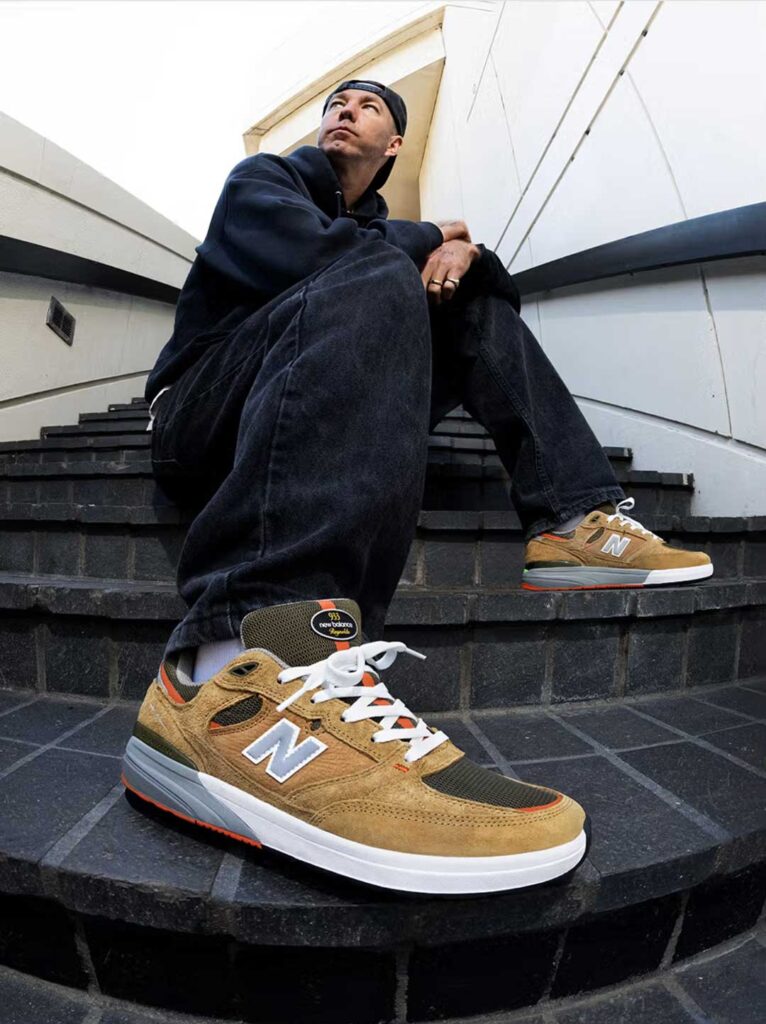
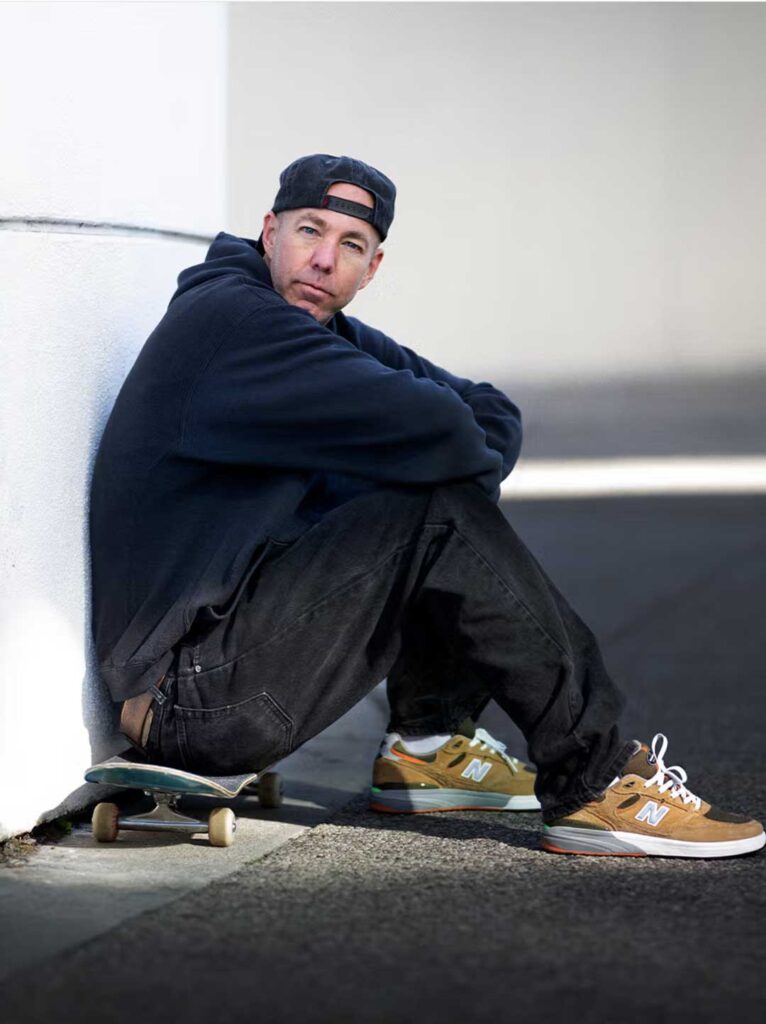
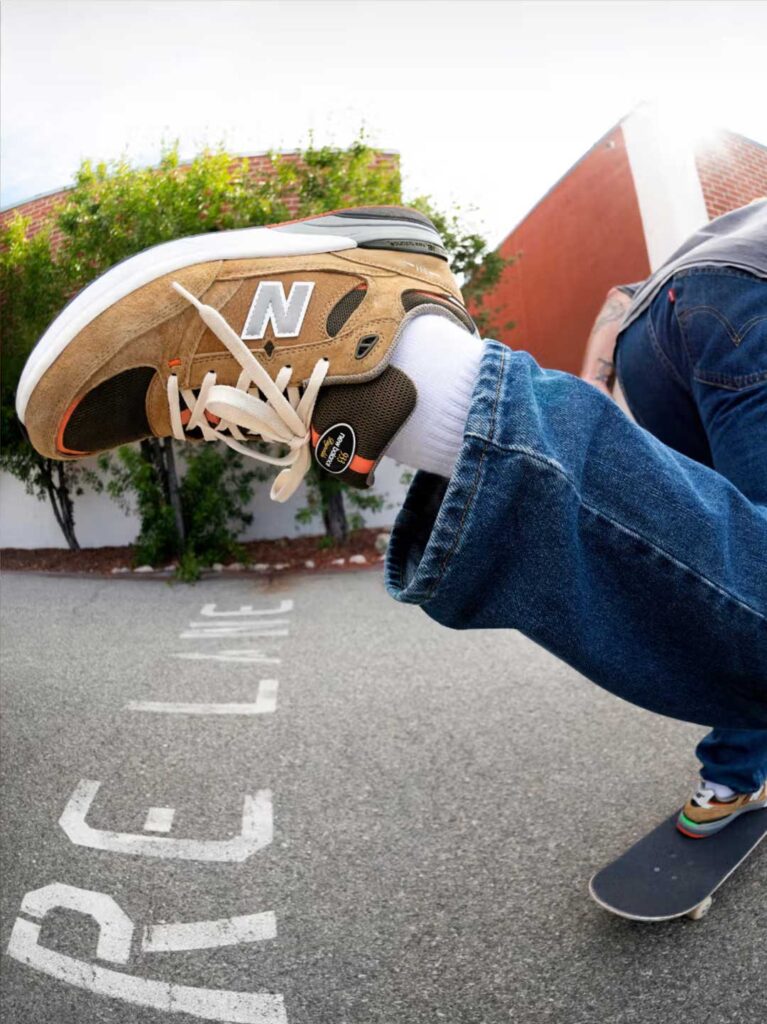
Inside the midsole is where the most important performance tech lives. The 933 features New Balance’s ABZORB foam cushioning, which is designed to handle heavy impacts while keeping the shoe feeling responsive. Instead of just a single slab of foam, the midsole is built from two different densities – softer foam in the centre to help with board feel and comfort, and a firmer foam around the edges to keep the shoe stable and supportive. The foams are thermally bonded without glue, which keeps them from separating over time and enhances durability.
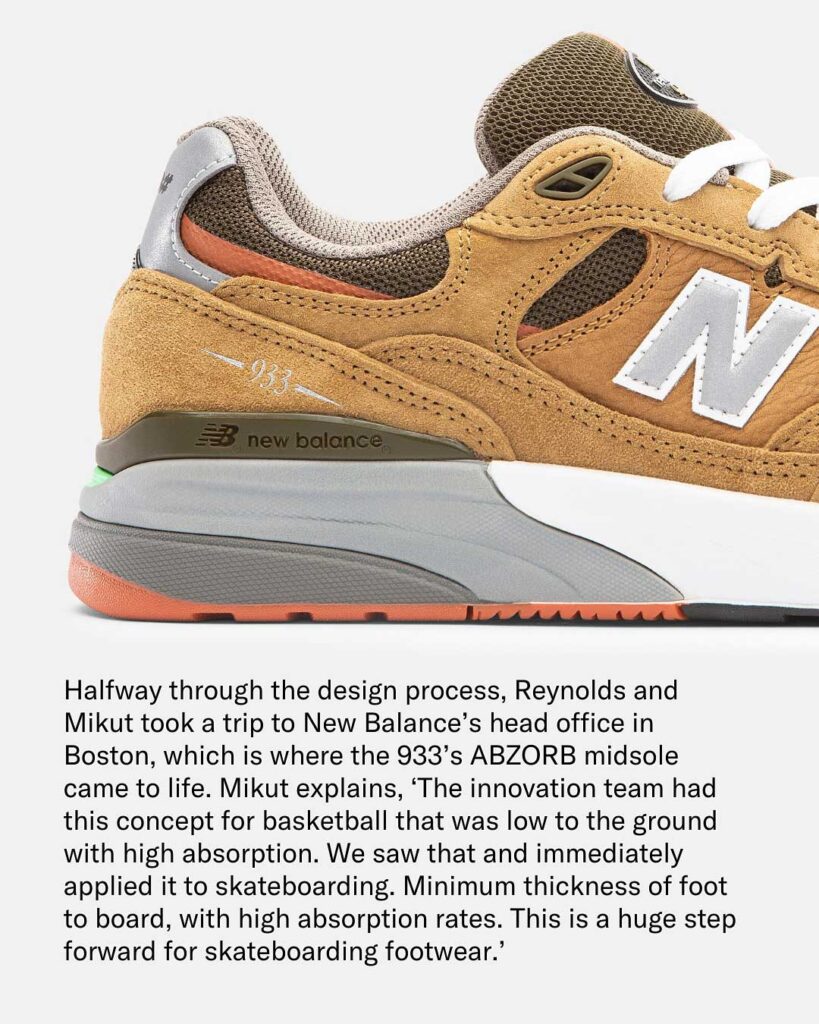
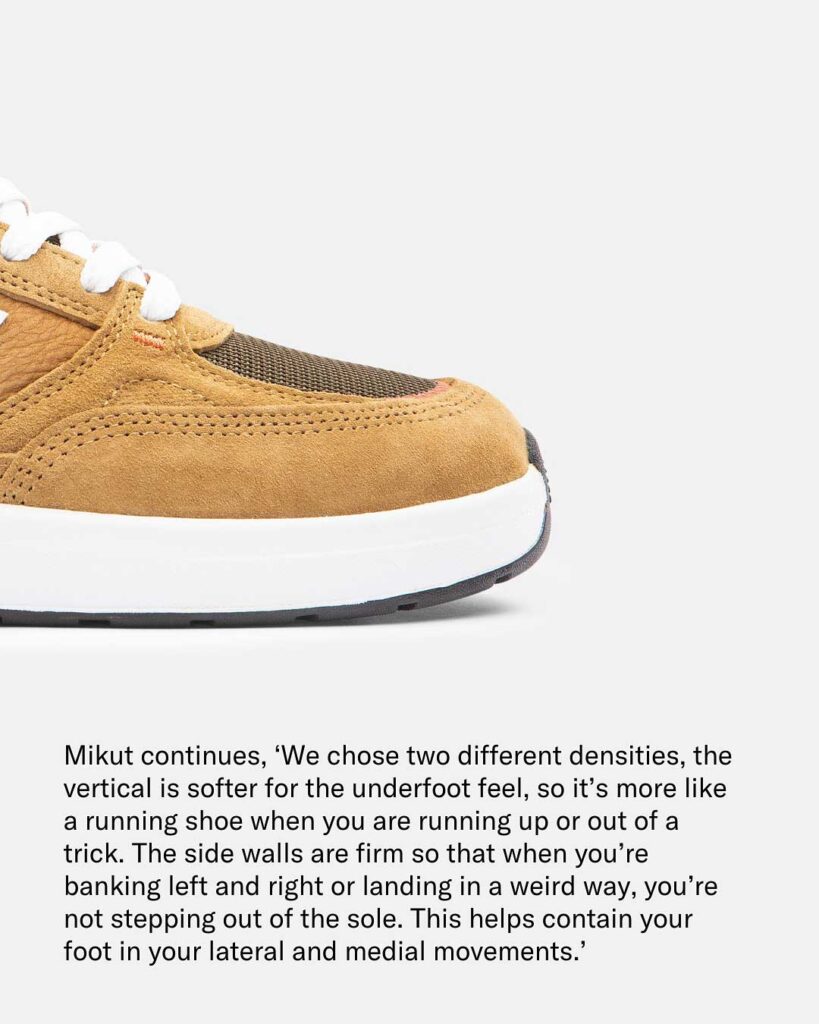
Underneath, the outsole is constructed with New Balance’s NDurance rubber, offering long-lasting grip and traction. The tread pattern was designed to resemble the 993’s running outsole while still supporting proper board feel and control. There’s also a midfoot shank plate hidden inside the sole – a piece of tech borrowed from New Balance’s basketball program – which helps stabilise landings and gives the shoe better energy transfer without adding stiffness in the forefoot.
Reynolds worked closely with the design team to incorporate personal touches that give the shoe character beyond just performance specs. Around the toe, there are ten small notches that represent important milestones in his life, though he’s deliberately left their meaning open to interpretation. On the heel, there’s a debossed cloud graphic hand-drawn by his daughter, adding a subtle but heartfelt detail.
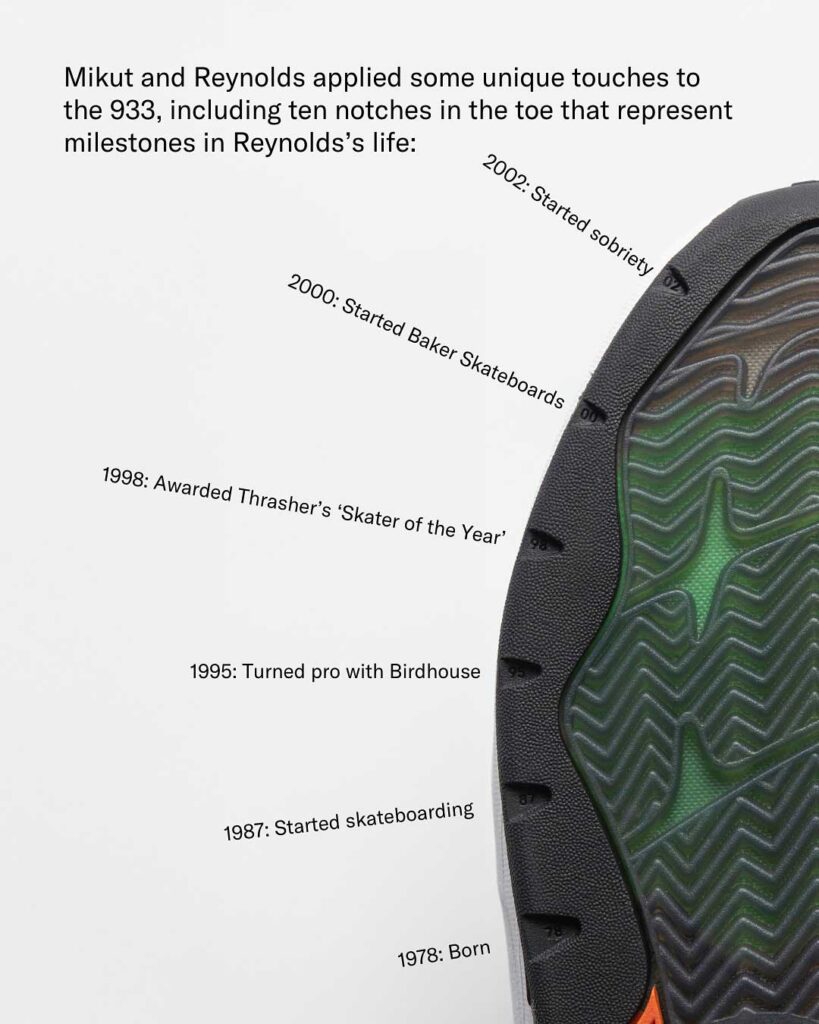
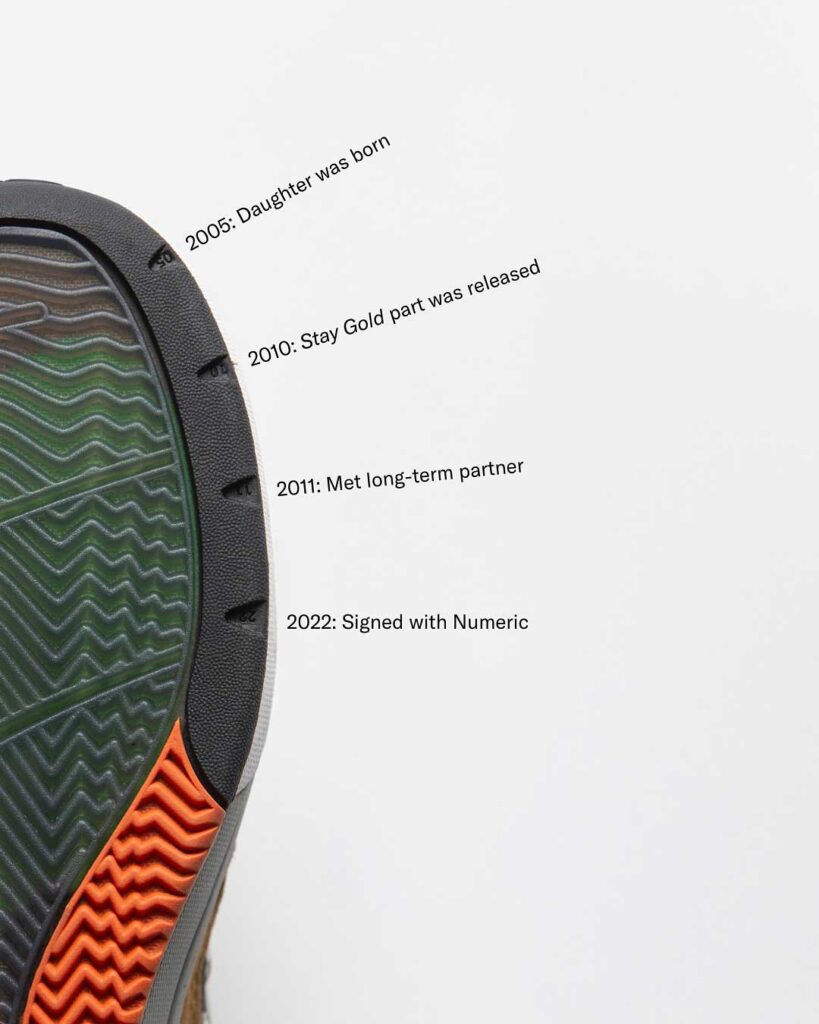
The shoe launched in a wheat-coloured suede upper, and is to be followed by a black and olive version. More colourways are planned throughout the year, including a limited “Grey Day” edition and an olive-based version with hiking-style details.
Overall, the 933 isn’t just a skate shoe – it’s a hybrid of everything Andrew Reynolds values: classic aesthetics, serious durability, and a personal connection to the design. It’s built to handle stairs, ledges, rails, and all the repeated impact that defines Reynolds’ skating style, while still feeling like something you’d want to wear whether you’re skating or not.

